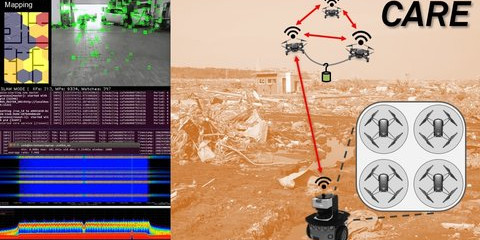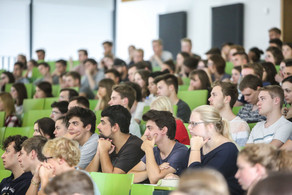CARE - Collaborative Aerial Rescue Robots in Emergency Response
- Project Group

The aim of the project group “CARE – Collaborative Aerial Rescue Robots in Emergency Response” is to realize a reference system using a drone-carrying ground robot which serves as base for a drone swarm. Multiple drones are supposed to carry out an exploration and sample-return mission in an unknown environment. To achieve the mission goal the drones have to collaborate under tight time- and communication constraints. The analysis of the impact of the communication system on the overall mission success is a particular focus of the project group.
The deployment of mobile and networked robotic systems that support rescue forces is a promising approach to increase safety and efficiency in disaster response missions. To enable such use cases, solutions for high-performance wireless communication between (heterogeneous) robots and operators are essential. Especially in the highly unpredictable conditions of disaster scenarios, solutions for highly reliable and robust communications have yet to be developed. When using open frequency bands, the drone communication links may be affected -for example- by interference by other users of the same band.
The aim of the project group “CARE – Collaborative Aerial Rescue Robots in Emergency Response” is to realize a reference system using a drone-carrying ground robot which serves as base for a drone swarm. Multiple drones are supposed to carry out an exploration and sample-return mission in an unknown environment. To achieve the mission goal the drones have to collaborate under tight time- and communication constraints. The analysis of the impact of the communication system on the overall mission success is a particular focus of the project group.
The envisioned tasks of the project group members are:
- Integration of the drone swarm (based on Ryze Tello EDU drones) and ground robot via a suitable ROS interface
- Implementation of the collaborative exploration and sample-return missions (ROS-based, C++/Python). The exploration shall include the derivation of a connectivity map of the scenario.
- Emulation of artificial degradation on the control link to challenge the communication links (shadowing, interference) leading to packet errors and delays
- Evaluation of the impact of degraded communications on the quality of the executed mission
- Develop concepts for the mitigation of degraded communication links to ensure stable execution of the rescue mission despite interference (e.g. routing of drone via connectivity hot spots)
Lehrstuhl: Lehrstuhl für Kommunikationsnetze
Betreuer: Philipp Gorczak, Janis Tiemann
Beginn ab: April 2019






